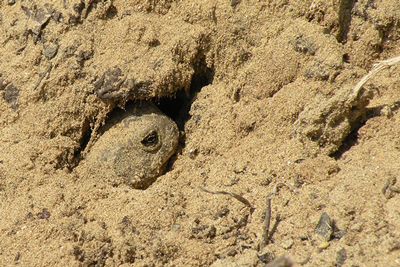
Canadian Toads
Wood Buffalo National Park
Canadian toads are found in Alberta, Saskatchewan and Manitoba as well as in the north-central United States. Their range in northern Alberta extends into the Northwest Territories, including in Wood Buffalo National Park. The Canadian toad populations within the park are the most northerly known within their range.
Canadian toads in Wood Buffalo National Park survive the cold subarctic winters by burrowing below the frost line into loose, sandy soils. Their burrowing areas are collectively called hibernacula, and they tend to return to the same wintering sites (hibernacula) year after year. Overwintering sites in northern regions such as the park often contain many individuals. One overwintering site in Wood Buffalo National Park near Fort Smith, NT, has been estimated to house several hundred hibernating toads. Other hibernacula within the park are found in exposed sandy cut-banks along NT Highway 5. The toads hibernate from September to May each year.

Why Monitor Canadian Toads?
Amphibians such as Canadian toads are sensitive to environmental change. The relative abundance of Canadian toads, as measured in Wood Buffalo National Park over time, can be an indicator of the health of the local ecosystem.
Methodology
When Canadian toads emerge in the spring, a small hole (one hole per toad) is left in the sand. Resource conservation staff visit the toad monitoring sites in Wood Buffalo National Park around mid-May to early June. This is done shortly after the toads have emerged in the spring, but before the openings of the holes are obscured by rain. Seven hibernacula are surveyed along NT Highway 5 each year, and the number of holes at each site is recorded. The hibernacula were discovered in 1989, and the emergent hole surveys began in the early 2000’s.
For More Information:
Amber Erasmus
Resource Management Officer
Wood Buffalo National Park
Ph. 867-872-7932
E-mail: amber.erasmus@pc.gc.ca
- Date modified :